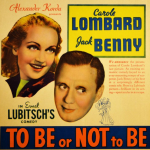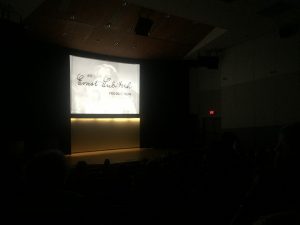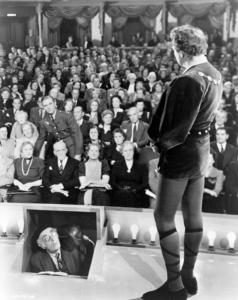
“To Be or Not to Be”. Hamlet’s soliloquy left me with unanswered questions as I picked up a pamphlet from within White Hall. “Resisting Fascism” was the theme of the screening as I found myself sitting with baby boomers from all over Atlanta browsing the newest addition of The Emory Wheel. The lit lecture hall contrasted perfectly with the dark night and eerie mood following the school lockdown. The apprehensiveness on campus following the incident seemed to be spreading as I noticed only a few students in the room with me.


As I hid myself in the back left corner of the hall, Paul Buchholz, a German studies professor, introduced himself on stage. Though everyone could tell he was quite nervous, Mr. Buccholz did a fantastic job emphasizing the historical importance of the film. It was at this moment that I became very puzzled. Professor Buccholz explained that the film was a dramatic comedy on Hitler’s dominance of Poland. I was pleased to see that I was not alone with my confusion as everyone checked to see if they had heard Mr. Buccholz correctly. Comedy and Hitler? How did that make any sense? He went on to praise the director, Ernest Lubitsch, for his unique approach to the film as he broke many barriers in the world of dramatic comedy. Mr. Buccholz said that Lubitsch’s use of comedy was to “unsettle the audience not relieve it” and called this technique “the Lubitsch touch”. Combining this approach with the delicate topic of the Nazi regime, many contemporary critics considered Lubitsch to be tasteless and inappropriate. Though his work was not exactly respected at the time, modern day researchers and film enthusiasts around the world praise Lubitsch’s forward thinking. Mr. Buccholz talked about the new wave of European filmmakers making their way to Hollywood in the early twentieth century and how Lubitsch served at the forefront of this revolutionary change. I was suddenly fascinated. Professor Buccholz then dimmed the lights after his conclusion and the film began.

The trailer (would not allow me to insert into post):
www.youtube.com/watch?v=7W_B10VbYjI.
Within minutes of the movie the audience was already jumping out of their seats in laughter as a man dressed up as Hitler was mocked in the streets. The film revolved around a Polish theater couple and their experiences with the invading Nazi regime. It almost seemed as if the comedic presence of the story increased with Hitler’s power. Whether it was mocking Polish culture or poking fun at the brainwashed Nazi officers, To Be or Not to Be seemed to shed light on the lack of humanity in the early 20th century.

I noticed a perfect example of Lubitsch’s technique with the use of the Hamlet’s soliloquy, “To Be or Not to Be”. The scene revolves around a man, Mr. Tura, and his performance of the soliloquy in the city theater. As Mr. Tura steps on stage with hundreds of people in attendance, his soliloquy is cut off by a man who gets up from the second row to meet Mr. Tura’s wife backstage. The awkwardness and irony of the scene left the audience bursting in laughter, but what makes it so interesting is the meaning behind the soliloquy. Written by Shakespeare, the monologue is about Hamlet and his suicidal thoughts as he compares death to a peaceful sleep. Though Professor Buccholz did not speak on this after the screening, I believe Lubitsch chose this soliloquy as the title to point out the irony of his own film. Though the monologue has a tense and depressing mood, Lubitsch makes the bold decision to combine it with the comedic value of romantic comedy. I believe this connects perfectly to the overarching theme of the movie as Lubitsch combines comedy with the dark topic of World War II.
Writing this exactly four days after the screening I still have not made my final stance on Lubitsch’s work. His ability to take something so sinister and transform it into a playful matter was a skill Hollywood had never seen before. Though many praise the film today, I started to think about the other perspectives such as the Jewish community and all those affected by Hitler’s reign. With art often acting as a catalyst for conversations regarding social change, I began to question whether there should be a line in what is appropriate for mainstream works. When do artists take it too far? Though I am a firm believer in freedom of expression, it is important to be aware of the feelings of others and how different cultures might view your work.
If you are interested in future screenings from “Resisting Fascism” I would highly recommend attending. Below I have listed the dates and films.
Wednesdays 7:30pm, White Hall 208, Free
9/27: Hangmen Also Die
10/4: The Stranger
10/11: Naked Among Wolves
10/18: Army of Shadows
10/25: The Conformist
11/1: The Tin Drum
11/8: Amen
11/15: The Counterfeiters
Pictures/Videos:
Danios12345. “To Be Or Not To Be (1942) Trailer.” YouTube, YouTube, 16 Sept. 2011, www.youtube.com/watch?v=7W_B10VbYjI.
Lemaster, Dana. “Dana Lemaster.” Thinking Cinema, 19 June 2015, www.thinkingcinema.com/film-appreciation-to-be-or-not-to-be/.
“Paul J. Buchholz, PhD.” Department of German Studies, german.emory.edu/home/people/faculty/buchholz-paul.html.
“To Be or Not to Be (1942).” IMDb, IMDb.com, www.imdb.com/title/tt0035446/mediaviewer/rm3433567232
-Michael Malenfant
